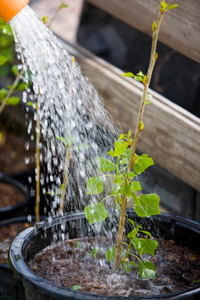To understand how gray water is absorbed by soil and plants, imagine emptying your backpack on the subway. That pile of stuff is much like gray water. It consists of various items that are useful or useless to the environment you introduced them to. There are certain items that will lie untouched — perhaps your smelly gym clothes or a really boring book. Plants and soil are much like the other train commuters. They’re ready to snatch the items they have the most use for and leave the less attractive ones behind.
Plants and soil work hard to break down gray water. Soil filters out many contaminants through a basic process:
- As water passes through layers of sand or granulated rock, larger water contaminants are caught in the grit of the dirt’s solids. This process is like straining solids out of soup with a colander, on a smaller scale. (If this sounds far fetched, remember that one key component in commercial water filters is charcoal.) The dirt itself helps filter out nutrients and biodegradable materials, which can then be absorbed by plants and bacteria.
- Microorganisms and bacteria in the ground feed off of carbon and pathogens, leaving water, carbon dioxide and non-polluting insolubles.
- The rest of the water, now purged of major pollutants, is absorbed by plants or seeps down to recharge the groundwater.
It’s important to remember that plant life varies greatly, and some species are unable to deal with the chemicals, salt or acidity levels in gray water. Other plants just call for careful watering and care to begin with. In many situations, drainage from kitchen sinks and dishwashers is too contaminated by grease and high acidity to be used at all.
Even without coming into contact with human waste or strong chemicals, gray water can contain food particles, grease, bacteria and some pathogens due to contact with our food, soaps and bodies. The yard can handle these elements, but that doesn’t mean you can.
Take care to prevent gray water from coming into contact with any fruits and vegetables due to the contamination risk (especially if the produce may be consumed raw). Fruit and nut trees are generally considered safe picks due to the distance between the ground and the food, but all other food gardens are best irrigated with white water or rain water. Additionally, gray water usage should be suspended altogether when a household resident is sick, as this only increases the contamination risk.
To further prevent contamination, don’t store gray water for reuse. If allowed to sit, gray water quickly turns into a stagnant, sludge-filled concoction of bacteria and pathogens — these elements thrive on some of the same nutrients a garden could benefit from. This feeding frenzy needs to take place in the soil, as described above, not in your tank. If gray water is collected and stored without treatment, it effectively becomes black water in as little as 24 hours.
But what kind of system gets all that gray water out to the garden? How much is the installation cost? It can all be as simple as grabbing a bucket.
Source: https://science.howstuffworks.com
Dear User/Visitor! Please, answer on our questions: tick off one of the positions – your answer will make us able to improve our site and make it more interesting and useful!


